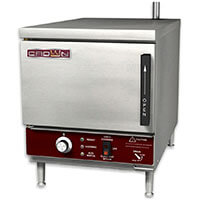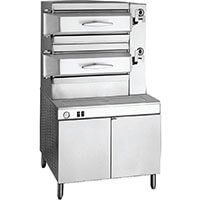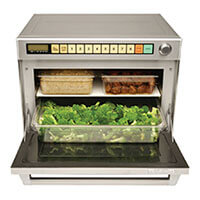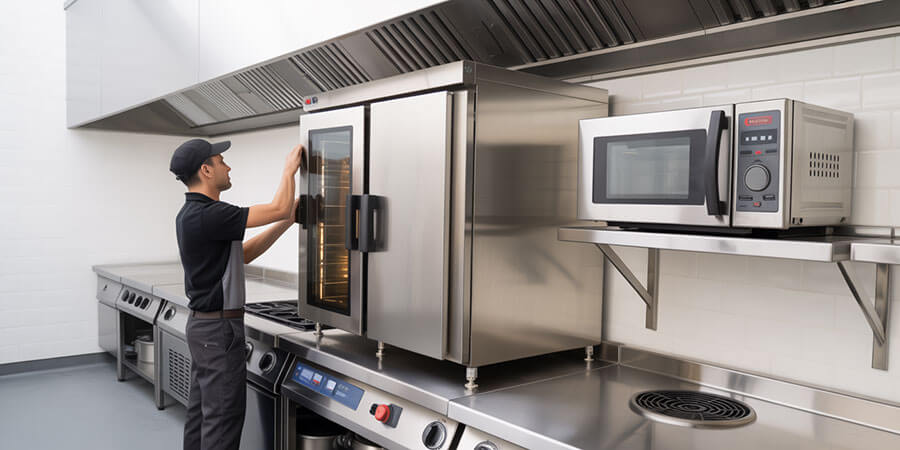Commercial Steamer Guide: Convection, Pressure & Microwave

Table of Contents
Everything you need to know about choosing commercial steamers for your business
Complete Steamer Technology Guide
The Business Case for Commercial Steamers
Imagine walking into your restaurant's kitchen during the dinner rush. Orders are flying in, and your staff needs to prepare multiple dishes simultaneously. A commercial steamer can be the difference between controlled chaos and seamless efficiency.
Steam cooking has revolutionized food service by offering a healthier alternative to traditional frying and baking methods. Unlike microwaves that can create hot spots and uneven cooking, commercial steamers provide consistent, gentle heat that preserves moisture, nutrients, and natural flavors.
Revenue Impact:
Restaurants with strong steaming programs often see 25-35% higher margins on steamed menu items. A well-executed steamer program can generate $300-$800 in daily revenue from items like perfectly steamed vegetables, seafood, and specialty dishes.
Operational Benefits:
- Faster service: Steam cooking is typically 40-60% faster than traditional methods
- Labor efficiency: Reduced monitoring and stirring requirements
- Menu expansion: Ability to offer healthy, diet-specific options
- Cost control: Minimal oil usage and reduced food waste
Commercial Steamer Technologies: Convection, Pressure & Microwave
When selecting a commercial steamer, you'll choose from three main technologies: convection, pressure, and microwave steamers. Each offers distinct advantages depending on your restaurant's size, menu requirements, and operational needs.
Convection Steamers: The Versatile Workhorse

Convection steamers represent the majority of commercial steaming equipment and are widely regarded as the most versatile option for most restaurant kitchens. These systems use powerful fans to circulate steam evenly throughout the cooking chamber, ensuring consistent results across all pans.
Unlike traditional steamers that rely on natural convection, convection models actively move steam around the cooking cavity, eliminating cold spots and ensuring every item cooks uniformly. This makes them ideal for high-volume operations where consistency is paramount.
The technology works by heating water in a reservoir to create steam, which is then distributed through strategically placed vents and circulated by internal fans. This creates a gentle, moist cooking environment that preserves the natural moisture, texture, and nutritional value of foods while preventing overcooking or drying out.
How convection steamers work:
Water is heated to create steam, which is then circulated by fans to maintain even temperature distribution. This creates a gentle cooking environment that preserves moisture and delicate textures.
Key advantages for restaurants:
- Consistent results: Even heat distribution prevents overcooking
- Versatile cooking: Excellent for vegetables, seafood, eggs, and delicate proteins
- Easy operation: Most models have simple digital controls
- Lower maintenance: Fewer moving parts than pressure systems
Best restaurant applications:
- Full-service restaurants offering healthy menu options
- Cafes focusing on fresh, nutritious meals
- Operations requiring consistent batch cooking
- Facilities with varying menu demands
Pressure Steamers: High-Speed Performance

Pressure steamers operate under elevated pressure (typically 15-20 PSI) to achieve higher cooking temperatures, making them the fastest option for commercial steaming applications. These powerful systems create a sealed cooking environment where steam pressure builds up, raising the boiling point of water to approximately 250°F (121°C) - significantly higher than standard atmospheric boiling.
This pressurized cooking method dramatically reduces cooking times while maintaining food quality and nutritional value. The technology works by sealing the cooking chamber completely, allowing pressure to build as steam accumulates.
Once the desired pressure is reached, the intense heat penetrates food more rapidly, cooking dense items like root vegetables, tough proteins, and large cuts of meat in a fraction of the time required by convection steamers. Pressure steamers are particularly effective for high-volume operations where speed is critical, such as institutional cafeterias, catering operations, and busy restaurants serving large groups.
How pressure steamers work:
Steam is pressurized within a sealed chamber, raising the boiling point to approximately 250°F (121°C). This allows for rapid cooking while maintaining food quality.
Key advantages for restaurants:
- Speed: Up to 70% faster cooking times than convection models
- High capacity: Ideal for large batch production
- Energy efficiency: Shorter cooking times reduce energy consumption
- Dense food handling: Better for root vegetables and tougher proteins
Best restaurant applications:
- High-volume operations like cafeterias and buffets
- Institutional foodservice operations
- Catering companies needing rapid production
- Operations with limited kitchen space but high demand
Microwave Steamers: Rapid Cooking Innovation

Microwave steamers combine microwave technology with steam generation to deliver exceptionally fast cooking times while maintaining food quality and nutrition, representing the cutting edge of commercial steaming technology. These innovative systems use electromagnetic waves to heat water molecules directly, creating steam almost instantly and dramatically reducing warm-up times.
Unlike traditional steamers that must heat large volumes of water, microwave steamers generate steam on-demand through precise microwave energy application. The technology works by directing microwave energy toward a water reservoir, where it agitates water molecules at incredible speeds, creating steam in seconds rather than minutes.
This rapid steam generation, combined with the penetrating power of microwave energy, results in cooking times that can be up to 70% faster than conventional steamers. Microwave steamers excel at quick reheating, portion-controlled cooking, and high-volume operations where speed is paramount, making them ideal for quick-service restaurants, food trucks, and operations with limited space but high throughput requirements.
How microwave steamers work:
These specialized units use microwave energy to heat water and create steam rapidly, then combine both microwave and steam cooking methods for optimal results.
Key advantages for restaurants:
- Ultra-fast cooking: Significantly faster than traditional steamers
- Energy efficient: Lower power consumption for quick operations
- Compact design: Smaller footprint than conventional steamers
- Consistent results: Advanced controls ensure uniform cooking
Best restaurant applications:
- Quick-service restaurants needing rapid meal preparation
- Food trucks and mobile catering operations
- Limited-space kitchens requiring high efficiency
- Operations with variable menu demands and timing constraints
Considerations for microwave steamers:
- Power requirements: Higher electrical demands than standard units
- Menu limitations: Best suited for specific food types and portion sizes
- Cost premium: Higher initial investment than basic convection models
- Training requirements: Staff need to understand microwave steaming principles
Convection Steamer Types and Technologies
Convection steamers come in several configurations, each designed for different operational needs and facility constraints.
Boilerless Convection Steamers
Boilerless convection steamers are the most popular choice for commercial kitchens. They heat water in a reservoir beneath the cooking chamber, generating steam on-demand without traditional boiler maintenance.
What makes them ideal:
- Lower initial cost: Typically 20-30% less expensive than boiler-based models
- Simplified maintenance: No boiler cleaning or water treatment required
- Energy efficient: Only generates steam when needed
- Compact design: Fits well in limited kitchen spaces
Perfect for:
- Quick-service restaurants with limited budgets
- Small to medium-sized operations
- Facilities without dedicated boiler rooms
- Restaurants with variable production needs
Connectionless Convection Steamers
Connectionless convection steamers take flexibility to the next level by eliminating the need for water and drain connections. These self-contained units can be placed virtually anywhere in your kitchen.
Key features:
- Self-contained water system: Manual filling eliminates plumbing requirements
- Built-in drainage: Collects and holds water for easy disposal
- Portable design: Easy to move between locations
- No installation complexity: Just plug in and start cooking
Ideal applications:
- Existing kitchens with limited plumbing
- Food trucks and mobile catering operations
- Seasonal or pop-up restaurant concepts
- Facilities planning future renovations
Generator-Based Convection Steamers
Generator-based convection steamers use dedicated steam generators for high-capacity performance. These systems are designed for operations that demand continuous, high-volume steaming.
Advanced capabilities:
- Dedicated steam generation: Separate generator ensures consistent steam quality
- High capacity: Can handle 10-24 pans simultaneously
- Rapid recovery: Quick heat-up between cooking cycles
- Professional controls: Advanced programming for complex menus
Best suited for:
- Large restaurants with high-volume demands
- Institutional foodservice operations
- Catering companies requiring rapid production
- Operations with 200+ daily meal services
Direct Steam Convection Steamers
Direct steam convection steamers connect to building steam systems, offering instant high-capacity steaming capabilities.
Technical integration:
- Connection to existing building steam lines
- Immediate steam availability without warm-up
- Consistent steam pressure and quality
- Integration with facility infrastructure
Operational advantages:
- No warm-up time required
- Unlimited steam capacity for continuous operation
- Lower energy costs through building system utilization
- Reliable performance during peak demand periods
Commercial applications:
- Large hotels and resorts
- Institutional facilities with steam infrastructure
- Multi-unit restaurant operations
- Facilities with existing steam distribution systems
Power and Fuel Options for Commercial Steamers
Choosing the right power system depends on your facility's infrastructure, energy costs, and operational priorities. Here's a quick comparison of the three main options:
| Aspect: | Electric Steamers: | Gas Steamers: | Microwave Steamers: |
| Voltage/Power | 208V, 240V, or 480V. Three-phase. 8-48 kW consumption. | 150K-400K BTU/hr. Natural gas or propane. | 208-240V. Single/Three-phase. 2.2-3.2 kW consumption. |
| Installation | Easier: Standard electrical. Dedicated circuits required. | Complex: Certified gas technician. Ventilation hood needed. | Specialized: Licensed electrician. Commercial microwave experience. |
| Energy Cost | Higher per hour. Precise control saves waste. | Lower for high-volume use. Cost-effective for large operations. | Moderate consumption. Efficient for quick operations. |
| Best For | Urban locations, clean environments. Facilities without gas service. | High-volume operations. Existing gas infrastructure. | Quick-service needs. Limited space applications. |
| Key Benefits | Precise temperature control. Quiet, clean operation. No ventilation required. | Rapid heating & recovery. High capacity performance. Reliable peak demand output. | Ultra-fast cooking times. Compact footprint. Energy efficient for speed. |
Understanding Your Power Choices
Each power system offers distinct advantages depending on your restaurant's specific situation. The table above provides a quick overview, but let's dive deeper into when each option makes the most sense.
Electric steamers shine when:
- Your facility lacks gas infrastructure (common in urban areas)
- Quiet operation is important for customer-facing environments
- Precise temperature control is critical for delicate menu items
- You want the cleanest, simplest installation process
Gas steamers excel in:
- High-volume operations where speed and capacity matter most
- Facilities with existing gas lines and ventilation systems
- Budget-conscious operations with heavy daily usage
- Situations requiring rapid recovery between cooking cycles
Microwave steamers work best for:
- Quick-service restaurants needing ultra-fast meal preparation
- Food trucks and mobile operations with limited space
- Facilities prioritizing speed over traditional cooking methods
- Operations with stable high-voltage electrical service
The key is matching the power system to your specific operational needs, facility constraints, and long-term energy costs. Consider consulting with a professional installer to evaluate your current infrastructure before making a final decision.
Capacity Planning: Matching Steamers to Your Operation
Selecting the right steamer capacity requires understanding your menu composition, service style, and peak demand periods.
Understanding Pan Capacities
Commercial steamers are measured by their pan capacity, with standard configurations designed for different operational needs.
Standard pan sizes:
- Full-size pans: 12" x 20" x 2.5" (most common in commercial kitchens)
- Half-size pans: 12" x 10" x 2.5" (ideal for smaller portions)
- Third-size pans: 12" x 6.5" x 2.5" (perfect for side dishes)
Capacity guidelines by operation type:
| Restaurant Type: | Daily Meals: | Recommended Capacity: | Peak Load Capacity: |
| Quick Service | 200-500 | 3-6 pan steamer | 6-10 pan system |
| Casual Dining | 300-800 | 5-10 pan steamer | 10-16 pan system |
| Fine Dining | 100-300 | 3-5 pan steamer | 5-8 pan system |
| Institutional | 1,000+ | 12-24 pan system | Multiple units |
Production Volume Calculations
Calculate your steaming needs based on menu requirements and service patterns.
Key factors to consider:
- Menu composition: What percentage of items require steaming?
- Service style: Batch cooking vs. continuous production
- Peak demand periods: Lunch/dinner rushes requiring rapid output
- Menu complexity: Simple vegetables vs. complex multi-component dishes
Simple capacity formula:
Required Capacity = (Meals per hour × Items per meal × Cooking time) ÷ 60
Example: A casual dining restaurant serving 400 meals per day with 3 steamed items per meal and 10-minute average cooking time would need approximately 200 pan-hours per day.
Installation and Operational Requirements

Proper installation ensures safe, efficient steamer operation and compliance with local codes.
Electrical Installation Considerations
Electric steamers require careful electrical planning to ensure safe and reliable operation.
Essential requirements:
- Dedicated circuits: Separate electrical service from other kitchen equipment
- Voltage verification: Match equipment specifications exactly (208V, 240V, or 480V)
- Amperage capacity: 30-100 amps depending on model and capacity
- Ground fault protection: GFCI protection for wet environments
Installation checklist:
- Verify electrical panel capacity and available amperage
- Install appropriate circuit breakers and wiring
- Ensure proper grounding and GFCI protection
- Schedule professional electrical inspection
Gas Installation Requirements
Gas steamers require specialized installation by certified technicians to ensure safety and proper operation.
Key specifications:
- Pipe sizing: Minimum 1" diameter for natural gas lines
- Pressure testing: Verify system pressure meets equipment requirements
- Shut-off valves: Manual and automatic safety systems
- Ventilation: Adequate exhaust hood for combustion byproducts
Safety considerations:
- Carbon monoxide detection systems installation
- Proper gas pressure regulators and shut-off valves
- Emergency shut-off procedures and staff training
- Annual inspection and maintenance requirements
Space and Environmental Planning
Proper space allocation ensures safe and efficient steamer operation.
Clearance requirements:
- Rear clearance: 6-12 inches for ventilation and servicing access
- Side clearance: 3-6 inches for maintenance and air circulation
- Front clearance: 24-36 inches for loading and unloading pans
- Overhead clearance: 12-18 inches above the unit for proper ventilation
Environmental factors:
- Temperature range: 50°F to 100°F (10°C to 38°C) operating environment
- Humidity control: Maximum 85% relative humidity
- Ventilation: Adequate exhaust for heat and moisture removal
- Floor loading: Verify floor can support unit weight (200-800 lbs)
Cost Analysis and ROI Considerations
Investing in a commercial steamer requires understanding both upfront and ongoing costs.
Investment Ranges by Type
| Equipment Type: | 3-Pan Unit: | 6-Pan Unit: | 10-Pan Unit: |
| Electric Convection | $8,000-$12,000 | $12,000-$18,000 | $18,000-$25,000 |
| Gas Convection | $10,000-$15,000 | $15,000-$22,000 | $22,000-$30,000 |
| Pressure Steamer | $12,000-$18,000 | $18,000-$25,000 | $25,000-$35,000 |
Annual Operating Costs
Energy consumption:
- Electric models: $800-$2,500 per year
- Gas models: $1,200-$3,500 per year
- Cost depends on local utility rates and usage patterns
Maintenance expenses:
- Annual servicing: $300-$800 depending on model and usage
- Parts replacement: $100-$400 for filters and components
- Cleaning supplies: $100-$300 for specialized cleaners
ROI Calculation Framework
Break-even analysis:
Annual Savings = (Traditional cooking labor × hourly rate) + (Energy savings × utility cost) + (Food waste reduction × food cost)
Payback Period = Initial investment ÷ Annual savings
ROI Percentage = (Annual savings ÷ Initial investment) × 100
Typical savings breakdown:
- Labor efficiency: 20-40% reduction in cooking labor requirements
- Energy savings: 30-50% lower utility costs than traditional cooking
- Food waste reduction: 15-25% less waste through precise portioning
- Menu premium pricing: 10-15% higher prices for healthy steamed options
Real-world example:
A $15,000 gas convection steamer investment with $4,000 annual savings provides a 3.75-year payback period and 160% ROI over 7 years.
Equipment Selection Guide by Restaurant Type
Quick-Service Restaurants (QSR)
Capacity needs: 3-6 pan units for rapid production during busy periods
Technology options:
- Primary: Connectionless convection steamers for flexibility and ease of use
- Alternative: Microwave steamers for ultra-fast cooking when space is limited
- Power option: Electric for easy installation, gas for high-volume efficiency
Key features to prioritize:
- Fast recovery times between cooking cycles
- Simple digital controls for quick staff training
- Compact footprint to maximize limited counter space
Casual Dining Restaurants
Capacity needs: 5-10 pan units to handle diverse menu offerings
Technology options:
- Primary: Convection steamers with advanced temperature control
- Alternative: Gas convection for higher capacity and efficiency
- Consider: Pressure steamers for faster cooking of denser menu items
Key features to prioritize:
- Multiple cooking modes for menu variety
- Consistent results across different food types
- Professional controls for complex menu items
Fine Dining Establishments
Capacity needs: 3-5 pan units with emphasis on quality and consistency
Technology options:
- Primary: Electric convection systems with precise temperature management
- Alternative: Connectionless convection for maximum flexibility
- Consider: Smaller microwave steamers for specialty applications
Key features to prioritize:
- Gentle cooking that preserves delicate textures
- Moisture retention for premium presentation
- Quiet operation suitable for upscale environments
Institutional Operations
Capacity needs: 10-24 pan systems or multiple stacked units
Technology options:
- Primary: High-capacity gas convection or pressure systems
- Alternative: Direct steam convection for unlimited capacity
- Consider: Multiple microwave steamers for rapid batch cooking
Key features to prioritize:
- Continuous operation during peak meal periods
- Rapid production capabilities for large volumes
- Heavy-duty construction for demanding institutional use
Food Truck and Mobile Operations
Capacity needs: Compact 3-6 pan units that can operate on variable power
Technology options:
- Primary: Connectionless convection steamers for maximum portability
- Alternative: Compact microwave steamers for limited space
- Consider: Electric models that work with generator power
Key features to prioritize:
- Self-contained water systems (no plumbing required)
- Portable designs with carrying handles
- Quick setup and breakdown for mobile operations
Maintenance and Care Best Practices

Regular maintenance ensures optimal performance and extends equipment lifespan.
Daily Maintenance Routine
Essential daily tasks:
- Clean exterior surfaces with mild detergent solution
- Inspect door gaskets for wear and proper sealing
- Verify water levels and fill reservoirs as needed
- Test drain systems for proper operation
- Clean control panels and digital displays
Why daily cleaning matters:
Daily maintenance prevents mineral buildup, ensures consistent cooking results, and maintains food safety standards. A clean steamer operates more efficiently and lasts significantly longer.
Weekly Maintenance Procedures
Comprehensive weekly cleaning:
- Deep clean cooking chambers and removable racks
- Descale heating elements and steam generators
- Inspect and clean steam vents and outlets
- Check hose connections and fittings for leaks
- Calibrate temperature and pressure controls
Advanced weekly tasks:
- Test all safety systems and emergency shut-offs
- Verify proper drainage and water flow
- Clean condenser coils and moisture removal systems
- Lubricate any moving parts and hinges
Professional Service Guidelines
When to call for professional service:
- Inconsistent cooking results despite regular cleaning
- Unusual noises or vibrations during operation
- Error codes or malfunction indicators on digital displays
- Water leaks or unusual steam emissions
- Age-related maintenance (units over 5 years old)
Annual professional maintenance:
- Complete system inspection and performance testing
- Heating element replacement and calibration
- Safety system verification and certification
- Warranty work and manufacturer-recommended service
Choosing the Right Steamer Brand and Manufacturer
When selecting a commercial steamer, consider manufacturers that specialize in your preferred technology and offer strong support for commercial applications.
Key Brand Considerations
Technology Specialization:
- Convection-focused brands: Excel at versatile, consistent steaming for most restaurant applications
- Pressure system specialists: Offer high-speed solutions for demanding institutional environments
- Microwave steamer brands: Provide rapid cooking solutions with compact footprints
Support and Service:
- Warranty coverage: Look for comprehensive warranties (3-5 years typical)
- Service network: Local service availability and response times
- Parts availability: Easy access to replacement components
- Training support: Staff training programs and resources
Commercial Features:
- Durability: Heavy-duty construction for demanding commercial use
- Controls: Intuitive interfaces suitable for your staff skill level
- Energy efficiency: Advanced features that reduce operating costs
- Safety certifications: NSF, UL, and other relevant certifications
Researching Manufacturers
Key research steps:
- Read professional reviews from foodservice publications and industry associations
- Check user forums and owner communities for real-world experiences
- Contact local dealers for demonstrations and support availability
- Verify certifications and compliance with local health department requirements
- Compare warranties and service agreements from multiple manufacturers
Questions to ask:
- What is the typical lifespan of your steamers in commercial applications?
- How quickly can you provide service and parts?
- Do you offer staff training programs?
- What energy-saving features are available?
- How do your warranty terms compare to competitors?
Long-Term Partnership Considerations
Beyond the initial purchase:
- Upgrade paths: Availability of larger or more advanced models
- Technology integration: Compatibility with other kitchen equipment
- Software updates: Ongoing feature enhancements and support
- Environmental compliance: Adherence to changing energy and safety standards
Choose manufacturers with proven track records in commercial foodservice and strong commitments to ongoing support and innovation.
Frequently Asked Questions
What's the difference between convection and pressure steamers?
Convection steamers use fans to circulate steam evenly for gentle, consistent cooking of delicate foods. Pressure steamers operate under elevated pressure for faster cooking times, making them ideal for high-volume operations and denser foods.
How do I choose between electric and gas commercial steamers?
Electric steamers offer precise temperature control and easier installation, making them perfect for facilities without gas service. Gas steamers provide higher capacity and faster recovery times, making them ideal for high-volume operations with gas infrastructure.
When should I consider microwave steamers over traditional steamers?
Microwave steamers are ideal for quick-service operations needing ultra-fast cooking, limited-space kitchens, or food trucks. They're perfect when speed is prioritized and you have stable high-voltage electrical service. Consider traditional steamers for better texture control, larger batch cooking, or when cooking delicate foods that benefit from gentler heat.
What's the right capacity for my restaurant?
Quick-service restaurants (200-500 meals/day) typically need 3-6 pan units. Casual dining (300-800 meals/day) requires 5-10 pans. Institutional operations (1,000+ meals/day) need 12-24 pan systems. Consider your menu composition and peak demand periods.
How much does it cost to operate a commercial steamer?
Operating costs range from $1,500-$4,000 annually. Electric models cost $800-$2,500/year for energy, gas models $1,200-$3,500/year, plus $300-$800/year for maintenance. Most steamers pay for themselves within 1-2 years through labor savings and efficiency gains.
Can I install a commercial steamer myself?
While basic setup is straightforward, professional installation is recommended for electrical, gas, and ventilation systems. Improper installation can void warranties and create safety hazards. Always consult local codes and have systems inspected by certified technicians.
How often should I maintain my commercial steamer?
Daily exterior cleaning and weekly deep cleaning are essential. Professional maintenance should occur annually or every 6 months for high-volume operations. Regular cleaning prevents buildup, ensures consistent performance, and extends equipment life.
What's the typical lifespan of a commercial steamer?
With proper maintenance, commercial steamers last 10-15 years. Electric models often exceed 15 years, while gas models may need more frequent component replacement. Quality construction and regular maintenance significantly extend operational life.
Ready to invest in professional steaming equipment? Browse our comprehensive selection of convection, pressure, and microwave steamers designed for commercial kitchens:
- [Convection Steamers] - Versatile steaming solutions for most restaurant applications
- [Pressure Steamers] - High-speed cooking for demanding operations
- [Microwave Steamers] - Rapid cooking with compact footprints
- [Electric Steamers] - Clean, efficient operation
- [Gas Steamers] - High-capacity performance
Need help choosing the right steamer technology? Contact our foodservice specialists for personalized recommendations based on your menu, space, and production requirements.
Share This!